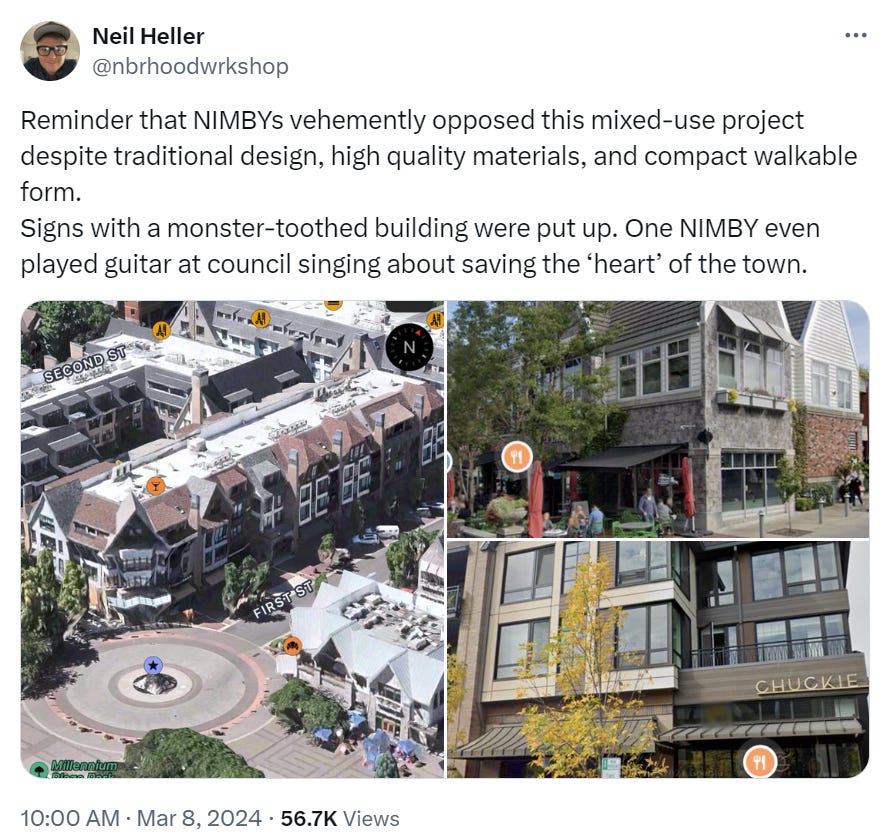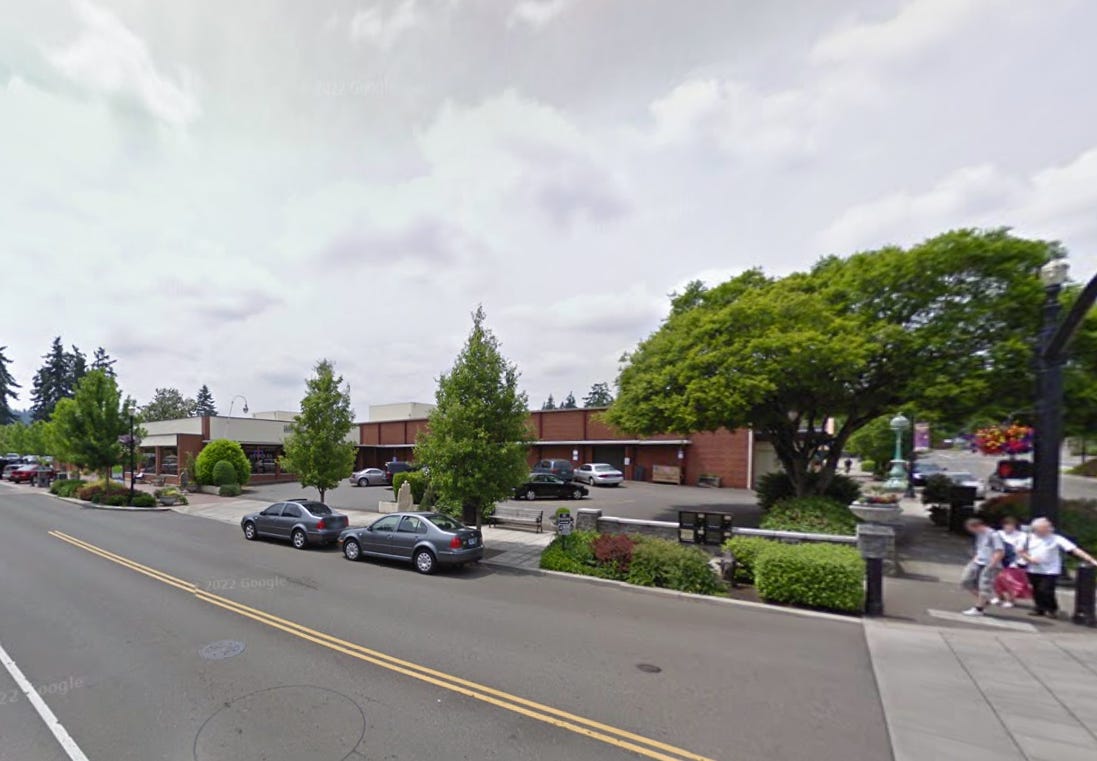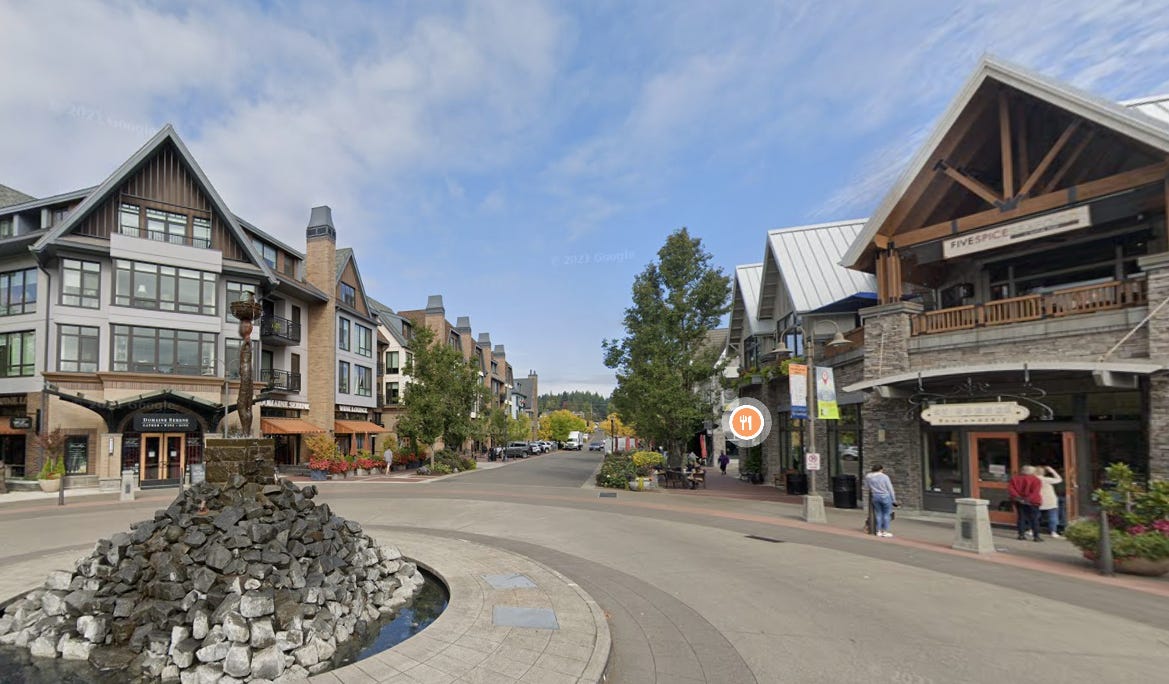If You Build It, They Won't Care
"Try it, you'll like it" applies to the built environment too
I saw this on Twitter recently:
He added in a reply: “Tremendous amounts of energy to stop something that they now have tacos and ice cream at like nothing ever happened. Amazing.”
What this development replaced might seem to be a salient question. Here’s what used to stand on most of the property:
One takeaway from this—which is hardly a unique or even uncommon story—is that (some) people will resist almost any change in the built environment for almost any reason. It will be for poor people, it will be for rich people, it’s too expensive, it’s too cheap, it will bring too much traffic, it will crowd people too closely together, it will be ugly, it will block sunlight, etc. etc. etc. You get this liberal counterculture protest stuff going on to stop a low-slung box store and a parking lot with a lovely walkable mixed-use development which, in any case, is just a couple of city blocks anyway.
That takeaway is kind of grim: nothing is too small to be bargained down or railroaded by NIMBYs who often don’t even have a coherent argument for why the new development is bad or why what’s there already is worth preserving.
But there’s another takeaway: nobody really cares! People don’t really feel that strongly about these things at the end of the day. They think they do; in the moment they get worked up about change and uncertainty and nostalgia. But at the end of the day, very few people in a year, or two years, or five years, will think when they go past the site “I miss when that was a different store” or “I wish that were still a strip mall.”
It reminds me of the furor that always erupts when a social media app or website changes the layout or icons or menus, or when a brand changes its logo. You’d think from the reactions that it’s a big deal, but within a few days, not only do you get used to the change, you often don’t even remember what it looked like previously. It feels like it was always the way it is now.
This is the human brain at work. Have you ever moved to a new place and thought about how you’ll miss some particular thing—the old kitchen sink, or the layout of a bathroom, or something—and find that pretty soon the new one “feels” just as natural to you? Have you ever “seen” old memories that happened in your old place taking place in the new one? Probably. I know I have. It’s strange having trouble visualizing memories in our old condo in those surroundings; If I recall something that happened in the kitchen or the bedroom or whatever room, I see it as those current rooms, not the ones we were in at the time.
Have you ever had a job or a relationship you thought you wanted to hold on to, and then realized not long after it ended that it’s a good thing you got out? Some device or gift you were sure you didn’t want, and then once you had it couldn’t imagine not having it?
These are all situations where change and flux occurs, and we get used to it, and on some level we know we’ll get used to it. NIMBYism in the built environment is an aberration, a rare case where this natural churn is slowed or stopped to the point where its natural pace comes to feel unnatural. And that’s self-reinforcing.
But nonetheless, once the damn thing finally gets built, people grumble, make their peace, and then come to like it.
It’s not possible to simply build the thing, because we do have all these rules, from zoning to public input, that slow the process down and introduce choke points and veto points. But to the extent that local politicians and officials have the discretion to go ahead and permit things, they generally should. People will tend to vote for what they know over what they don’t know, if asked. We’ll vote for lobster for dinner too, and unicorns, and eternal youth. Sometimes we don’t even know what we want, and we mistake familiarity with preference.
I’m not suggesting we get rid of public input entirely, or that we ignore the voices of local people. Nor am I suggesting that urbanism should be a kind of central planning, giving the dumb people what we know they really want. What I’d like to see is simply a restoration of a normal amount of change/churn/flux/demolition/building/renovation in our communities. That means reducing the power and discretion of planners and regulators.
And most people will be fine with the results.
Think of it this way: would anybody choose now to turn this back into parking lots and bland low-slung stores?
Me neither.
Related Reading:
Small Towns Are Everywhere And They All Look The Same
Thank you for reading! Please consider upgrading to a paid subscription to help support this newsletter. You’ll get a weekly subscribers-only piece, plus full access to the archive: over 900 pieces and growing. And you’ll help ensure more like this!







Love this post (and the development)
In my neighborhood there is an abandoned supermarket that's been empty and blighted for 9 or 10 years and yard signs all over protesting the owner's plan to build a mixed use apartment building. As if the abandoned, blighted supermarket and parking lot is an improvement! I often wonder if the apartment had been there and a crazy developer had announced plans to tear down the apartment building to build a blighted parking lot, whether the same people would have put up signs protesting THAT.
This piece along with a proposed MD sate law (Housing Expansion and Affordability Act of 2024) have me thinking about how people react to change. There are some elements of what I call "toxic nostalgia" for days gone by, but I think it's a more fundamental counterintuitive issue of allowing incremental change. The NIMBY-YIMBY argument always sets up to be binary; nothing or large scale change. I don't think either extreme is healthy for places. If we allow easy smaller change it will be more incremental and easier to accept, but you have to allow that. The question is how to implement this? This is an area that I have some cognitive dissonance with the bottoms up approach as that often bogs down with the NIMBY arguments. But then again the other end of the spectrum by imposing affordable housing anywhere (the proposed MD law) is a top down blunt instrument that will likely have unintended consequences. I keep coming back to making as much incremental stuff by right so that there is very low friction for both implementation and resistance. But residents and our legislators have a huge disdain for by right development and even when there is development that is by right, there are multiple required input sessions that bog things down. Ultimately, I like how you framed this, basically just take a deep breath and relax, the world won't come to an end. Maybe another way to put it is "pearl clutchers go home!" ;-)